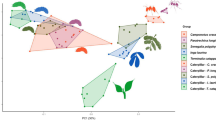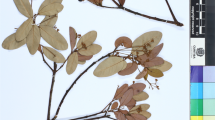Abstract
The soil — a pupation site of the larch thrips
The larch thrips pupates mainly in the uppermost layer of the soil, reaching down to 3 to 4 cm. Pupation takes further place on the base of needle-tufts on the larch tree. A description of the material and method used together with an outline of soil pupation within the order of Thysanoptera are given.
Similar content being viewed by others
Literaturverzeichnis
Bailey, S. F., 1940: Cocoon-Spinning Thysanoptera. Pan-Pacif. Ent.16, 2, 77–79.
Bonnemaison, L.;Bournier, A., 1964: Les Thrips du lin:Thrips angusticeps Uzel etThrips linarius Uzel (Thysanoptères). Ann. Epiphyties15, 2, 97–169.
Bournier, A.;Khochbav, A., 1965:Odontothrips conjusus Pr. nuisible à la luzerne. Ann. Epiphyties16, 1, 53–69.
Derbeneva, N. N., 1962: Biologija i postembrionalnoe razvitie Šalfejnogo tripsa —Taeniothrips fedorovi Priesner (Thysanoptera, Thripidae). [Biologie und Postembryonal-Entwicklung vonTaeniothrips fedorovi Priesner (Thysanoptera, Thripidae)]. Ent. Obozr.41, 2, 323–333.
Derbeneva, N. N., 1967: Novye dannye po biologii i stroeniju preimaginalnych faz i stadij chiščnogo tripsaAelothrips intermedius Bagnall (Thysanoptera, Aelothripidae). [New data on the biology and structure of preimaginal phases and stages of the predatory thripsAelothrips intermedius Bagnall (Thysanoptera) Aelothripidae)]. Ent. Obozr.46, 3, 629–644.
Franssen, C. J. H., 1960: Levenswijze en bestrijdings-mogelijkheden van de erwtetrips (Kakothrips robustus Uzel). [Biology and control of the pea thrips]. Versl. Landbouwk. Onderz. No.66, 4, 1–51.
Franssen, C. J. H.;Mantel, W. P., 1965: Tripsen in graangewassen (Levenswijze, economische betekenis en bestrijding). I. Levenswijze. [Thrips in cereal crops (biology, economic importance and control.) 1. Biology]. Centrum landbouwpubl. landbouwdocum. Wageningen, 1–97.
Harrison, J. O., 1963: Notes on the Biology of the Banana Flower Thrips,Frankliniella parvula, in the Dominican Republic (Thysanoptera: Thripidae). Ann. ent. Soc. Am.56, 664–666.
Kratochviĺ, J.;Farský, O., 1941: Třásň enka modřínova (Taeniothrips laricivorus n. sp.) původcem odumírání modřínových prýtů. [Der Lärchenblasenfuß (Taeniothrips laricivorus n. sp.) als Urheber des Absterbens von Lärchentrieben]. Lesn. Práce20, 233–272.
Kratochvíl, J.;Farský, O., 1942: Das Absterben der diesjährigen terminalen Lärchentriebe. Z. angew. Ent.29, 2, 177- 218.
Lewis, T., 1973: Thrips, their biology, ecology and economic importance. XV + 349 pp., Academic Press, London and New York.
Maksymov, J. K., 1965: Die Überwinterung des LärchenblasenfußesTaeniothrips laricivorus Krat. u. Far. Mitt. schweiz. Anst. forstl. Vers'wes.41, 1, 1–18.
Maksymov, J. K., 1972: Parthenogenese beim Lärchenblasenfuß,Taeniothrips laricivorus Krat. u. Far. (Thysanoptera, Thripidae). Anz. Schädlingskde., Pfl.-Schutz45, 4, 53–56.
Morison, G. D., 1970: Observations and records for some British Thysanoptera. XIII. Thripidae. The Linden Thrips,Thrips calcaratus Uzel. Entomologist's mon. Mag.106, 124–127.
Naegeli, W., 1944: Der Lärchenblasenfuß (Taeniothrips laricivorus Krat.), ein neuer Feind der Lärche. Schweiz. Z. Forstwes.9, 5/6, 175–180.
Nolte, H. W., 1951: Beiträge zur Morphologie und Biologie des Lä rchenblasenfußes (Taeniothrips laricivorus Krat.). Beitr. Ent.1, 2, 110–139.
Nolte, H. W., 1951: Die Feinde des Lärchenblasenfußes(Taeniothrips laricivorus). Ein Beitrag zur Bedeutung der räuberischen Feinde der Thysanopteren. Zool. Anz.146, 187–191.
Obrtel, R., 1963: Subterranean Phase of Metamorphosis inOdontothrips loti (Hal.) (Thysanoptera: Thripidae). Zool. Listy12, 2, 139–148.
Prell, H., 1942: Der Lärchenblasenfuß (Taeniothrips laricivorus Krat.) und das Lärchenwipfelsterben. Tharandt. forstl. Jb.93, 587–614.
Priesner, H., 1964: A Monograph of the Thysanoptera of the Egyptian Deserts. Publs. Ins. Désert É gypte Nr. 13, IX + 549 p. Imprimerie de l'Institut Français d'Archéologie Orientale, Le Caire.
Stannard, L. J., 1968: The Thrips, or Thysanoptera, of Illinois. Ill. nat. Hist. Surv. Bull.29, 4, 209–552.
Vité, J. P., 1956: Populationsstudien am LärchenblasenfußTaeniothrips laricivorus Krat. Z. ang. Ent.38, 417–448.
Author information
Authors and Affiliations
Rights and permissions
About this article
Cite this article
Maksymov, J.K. Der Boden als Verpuppungsort beim Lärchenblasenfuß Taeniothrips laricivorus Krat. u. Far. (Thysanoptera, Thripidae). Anz. Schadlingskde., Pflanzenschutz, Umweltschutz 49, 117–122 (1976). https://doi.org/10.1007/BF01985068
Issue Date:
DOI: https://doi.org/10.1007/BF01985068




